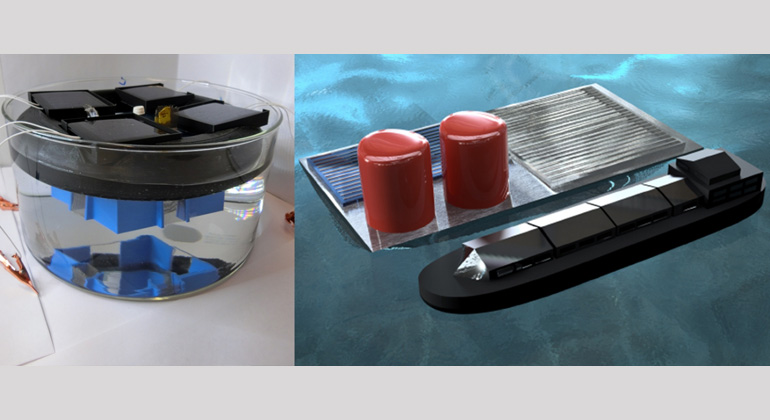Columbia Engineers Develop Floating Solar Fuels Rig for Seawater Electrolysis
Design is the first practical floating solar hydrogen-generating device to perform water electrolysis without pumps or membranes; could lead to low-cost, sustainable hydrogen production.
In a single hour, more energy from the sun hits the Earth than all the energy used by humankind in an entire year. Imagine if the sun’s energy could be harnessed to power energy needs on Earth, and done in a way that is economical, scalable, and environmentally responsible. Researchers have long seen this as one of the grand challenges of the 21st century.
Daniel Esposito, assistant professor of chemical engineering at Columbia Engineering, has been studying water electrolysis—the splitting of water into oxygen (O2) and hydrogen (H2) fuel—as a way to convert electricity from solar photovoltaics (PVs) into storable hydrogen fuel. Hydrogen is a clean fuel that is currently used to propel rockets in NASA’s space program and is widely expected to play an important role in a sustainable energy future. The vast majority of today’s hydrogen is produced from natural gas through a process called steam methane reforming that simultaneously releases CO2, but water electrolysis using electricity from solar PV offers a promising route to produce H2 without any associated CO2 emissions.
Esposito’s team has now developed a novel photovoltaic-powered electrolysis device that can operate as a stand-alone platform that floats on open water. His floating PV-electrolyzer can be thought of as a “solar fuels rig” that bears some resemblance to deep-sea oil rigs, except that it would produce hydrogen fuel from sunlight and water instead of extracting petroleum from beneath the sea floor. The study (DOI: 10.1016/j.ijhydene.2017.11.086), “Floating Membraneless PV-Electrolyzer Based on Buoyancy-Driven Product Separation,” was published today by International Journal of Hydrogen Energy.
The researchers’ key innovation is the method by which they separate the H2 and O2 gases produced by water electrolysis. State-of-the-art electrolyzers use expensive membranes to maintain separation of these two gases. The Columbia Engineering device relies instead on a novel electrode configuration that allows the gases to be separated and collected using the buoyancy of bubbles in water. The design enables efficient operation with high product purity and without actively pumping the electrolyte. Based on the concept of buoyancy-induced separation, the simple electrolyzer architecture produces H2 with purity as high as 99 percent.
“The simplicity of our PV-electrolyzer architecture—without a membrane or pumps—makes our design particularly attractive for its application to seawater electrolysis, thanks to its potential for low cost and higher durability compared to current devices that contain membranes,” says Esposito, whose Solar Fuels Engineering Laboratory develops solar and electrochemical technologies that convert renewable and abundant solar energy into storable chemical fuels. “We believe that our prototype is the first demonstration of a practical membraneless floating PV-electrolyzer system, and could inspire large-scale ‘solar fuels rigs’ that could generate large quantities of H2 fuel from abundant sunlight and seawater without taking up any space on land or competing with fresh water for agricultural uses.”
Commercial electrolyzer devices rely on a membrane, or divider, to separate the electrodes within the device from which H2 and O2 gas are produced. Most of the research for electrolysis devices has been focused on devices that incorporate a membrane. These membranes and dividers are prone to degradation and failure and require a high purity water source. Seawater contains impurities and microorganisms that can easily destroy these membranes.
“Being able to safely demonstrate a device that can perform electrolysis without a membrane brings us another step closer to making seawater electrolysis possible,” says Jack Davis, the paper’s first author and a PhD student working with Esposito. “These solar fuels generators are essentially artificial photosynthesis systems, doing the same thing that plants do with photosynthesis, so our device may open up all kinds of opportunities to generate clean, renewable energy.”
Crucial to the operation of Esposito’s PV-electrolyzer is a novel electrode configuration comprising mesh flow-through electrodes that are coated with a catalyst only on one side. These asymmetric electrodes promote the evolution of gaseous H2 and O2 products on only the outer surfaces of the electrodes where the catalysts have been deposited. When the growing H2 and O2 bubbles become large enough, their buoyancy causes them to detach from the electrode surfaces and float upwards into separate overhead collection chambers.
The team used the Columbia Clean Room to deposit platinum electrocatalyst onto the mesh electrodes and the 3D-printers in the Columbia Makerspace to make many of the reactor components. They also used a high-speed video camera to monitor transport of H2 and O2 bubbles between electrodes, a process known as “crossover.” Crossover between electrodes is undesirable because it decreases product purity, leading to safety concerns and the need for downstream separation units that make the process more expensive.
In order to monitor H2 and O2 crossover events, the researchers incorporated windows in all of their electrolysis devices so that they could take high-speed videos of gas bubble evolution from the electrodes while the device was operating. These videos were typically taken at a rate of 500 frames per second (a typical iPhone captures video at a rate of 30 frames per second).
The team is refining their design for more efficient operation in real seawater, which poses additional challenges compared to the more ideal aqueous electrolytes used in their laboratory studies. They also plan to develop modular designs that they can use to build larger, scaled-up systems.
Esposito adds: “There are many possible technological solutions to achieve a sustainable energy future, but nobody knows exactly what specific technology or combination of technologies will be the best to pursue. We are especially excited about the potential of solar fuels technologies because of the tremendous amount of solar energy that is available. Our challenge is to find scalable and economical technologies that convert sunlight into a useful form of energy that can also be stored for times when the sun is not shining.”








